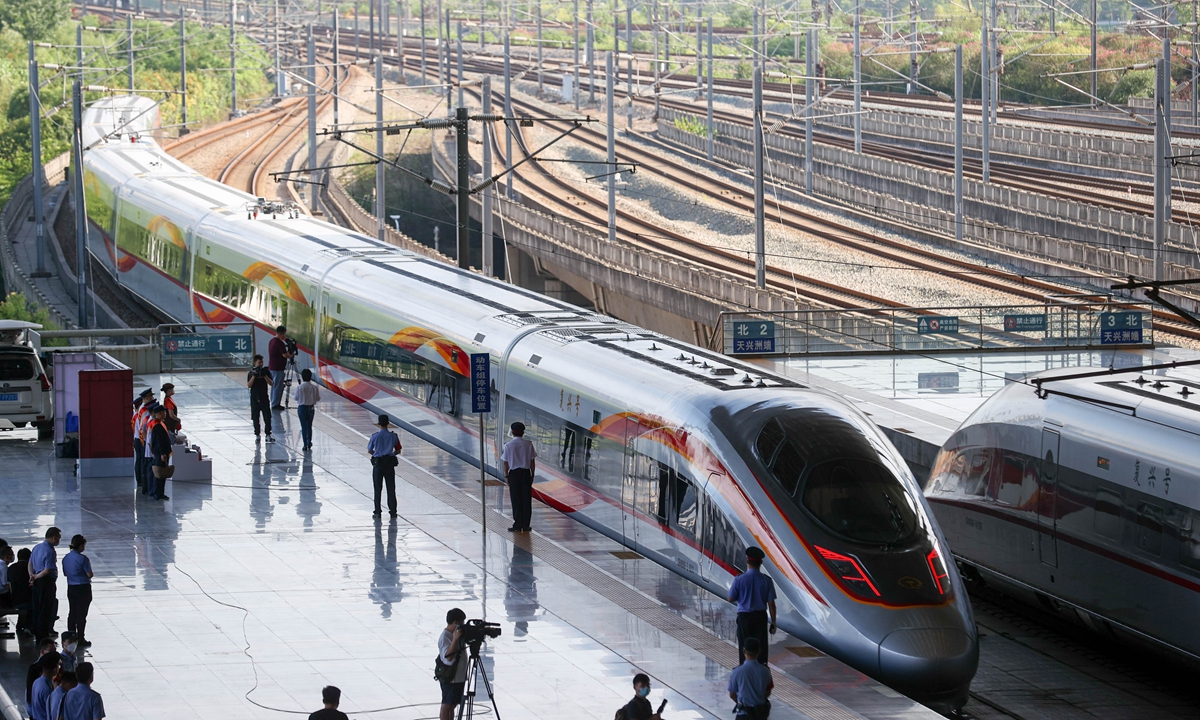Latest upgrades attest to China’s unrivalled prowess in high-speed railways
By GT staff reporters Published: Jun 20, 2022 11:52 PM
A bullet train departs from Wuhan, Central China's Hubei Province on June 20, 2022, the day when the Beijing-Wuhan section of the Beijing-Guangzhou high-speed link began operating at 350 kilometers per hour. Photo: cnsphoto
After making a round trip between Beijing and Central China's Zhengzhou nearly 700 kilometers apart in just a few hours,
on a high-speed rail journey departing from Beijing on Monday became the newest witnesses to China's unrivalled prowess in high-speed rail travel.
The Monday upgrade that saw the country's railway operator increase train speeds to 350 kilometers per hour from a maximum of 310 kilometers an hour on a section of the Beijing-Guangzhou high-speed rail link added to China's collection of monumental rail achievements, together with two other major high-speed rail upgrades on the same day.
The latest improvements epitomize the country's meteoric rise in the high-speed rail world that has increasingly revolved around Made-in-China technologies and standards. An ever-growing list of top titles has seen China being catapulted from a latecomer into a trendsetter in the high-speed revolution that originated with Japan's Shinkansen.
Such feats have made China's global lead in high-speed rail the object of admiration, especially for the US whose high-speed dream has been hanging in the air for decades, experts said. They reckoned the modernization of the US rail network to be largely elusive for President Joe Biden, or "Amtrak Joe," one of the nicknames he's known by due to his avid advocating for funding for US national rail operator Amtrak.
In stark contrast, the continued headway China has made in upgrading its high-speed rail network, despite some hiccups over the years, has helped to boost its economy and creates development miracles, the experts continued.
Envied latecomer
The high-speed railway linking Beijing and Wuhan in Central China's Hubei Province en route Zhengzhou, a section of the Beijing-Guangzhou high-speed railway, began operation at a standard speed of 350 km/h from 310 km/h on Monday.
After a burst of acceleration, the train's speed reached over 350 km/h from less than 200 km/h in just a few minutes. The Global Times reporter who travels between Beijing and Central China's Zhengzhou section saw some passengers place water bottles upside down on their tray tables to test the stability of the high-speed train.
The entire journey to Wuhan of about 1200 km has now been shortened by around half an hour to a minimum of 3 hours and 48 minutes.
If US ambassador to China Nicholas Burns were to travel by high-speed rail again to Wuhan in the future, he would probably be even more impressed by its speed.
During a visit to Wuhan from Beijing earlier in June, Burns tweeted, "Just crossed the Yellow River in Henan at the rapid clip of 308km per hour on this impressive Fuxing train."
Also on Monday morning, a bullet train departed from Southwest China's Chongqing Municipality for Beijing via Henan, marking the full operation of the Zhengzhou-Chongqing high-speed railway.
Additionally, Beijing Fengtai Railway Station, the largest railway hub in Asia,
on Monday. The reconstructed station has a total floor area of nearly 400,000 square meters, and will be able to accommodate a maximum of 14,000 passengers per hour.
The latest improvements build on the country's enviable rise to prominence in the global high-speed revolution.
China's high-speed rail network hit the 40,000-kilometer mark at the end of 2021, reaching out to 93 percent of domestic cities with a population of over 500,000, An Lusheng, deputy head of the National Railway Administration, disclosed earlier this month.
The numbers apparently consolidate the country's position as housing the world's largest high-speed rail network, although China's high-speed era only began on August 1, 2008 when the Beijing-Tianjin Inter-city Railway was put into operation at a top designed speed of 350 km/h.
Since then, China has reaped a growing number of top titles that have over the years cemented its global rail leadership.
In yet another sign, the Beijing-Zhangjiakou high-speed railway was launched at the end of 2019, the first railway of its kind to achieve autonomous driving at a speed of 350 km/h, solidifying China's top spot in high-speed rail technology.
Such achievements speak volumes about China's fast-track to high-speed rail leadership, despite some glitches over the past decade.
Design flaws and sloppy management were pinpointed as reasons behind a fatal bullet train crash near Wenzhou, East China's Zhejiang Province in July 2011, an official investigation found in late 2011.
In another setback, in 2013, former Railways Minister Liu Zhijun was given a suspended death sentence for accepting more than 64m yuan ($10m) in bribes over 25 years, notably, for awarding government rail contracts.
Sheng Guangzu, former secretary of the leading Party members group and general manager of the China Railway Corp, was revealed in March to be cooperating with an investigation by the country's top anti-graft body for suspected severe violations of discipline and laws.
These glitches did little to undercut China's unparalleled bullet train strength that has put the country's exports of high-speed rail technology and solutions in an advantageous position over early high-speed adopters such as Japan and some European countries, but has prompted the US to embark on an eager yet almost futile bullet train rush, observers said.
With high-speed rail becoming a calling card for the Chinese economy, the country's high-speed rail strength evidently goes far beyond its enabling of domestic connectivity, and has increasingly become a Chinese-origin edge in high-end manufacturing.
A typical example is the Jakarta-Bandung High-Speed Railway (HSR). With a design speed of 350 km/h, the HSR built with Chinese technology is set to cut the journey between Jakarta and Bandung, the capital of West Java province, from over three hours to about 40 minutes.
All this data stands in stark contrast to the US, which has been exploring high-speed rail transportation since the 1960s, around the time the first Japanese Shinkansen line was built, but has remained a laggard in making its vision a reality.
Even after Biden took office as US president, advancing the US high-speed rail push has remained rather elusive. Biden commuted via Amtrak during his decades in the Senate.
A multibillion-dollar infrastructure bill Biden signed into law late last year earmarked a small portion for transit and high-speed rail, but concerns remain that it will not be enough to modernize the country's aging passenger rail system, media reports said.
Infrastructure improvements in New Jersey would allow Amtrak's flagship high-speed service Acela trains to hit 241km/h per hour on a 25-km segment linking New Brunswick and South Brunswick, the railroad announced last week.
"I am not optimistic about the development of high-speed rail in the US. It is not because the US lacks the technology or funding, but because they don't realize the strategic significance of high-speed rail development for a country. On top of this, there are still many interest groups and lobby groups in the US that oppose the construction of high-speed rail," Tian Yun, a Beijing-based economist told the Global Times on Monday.
See link for rest of the article.


